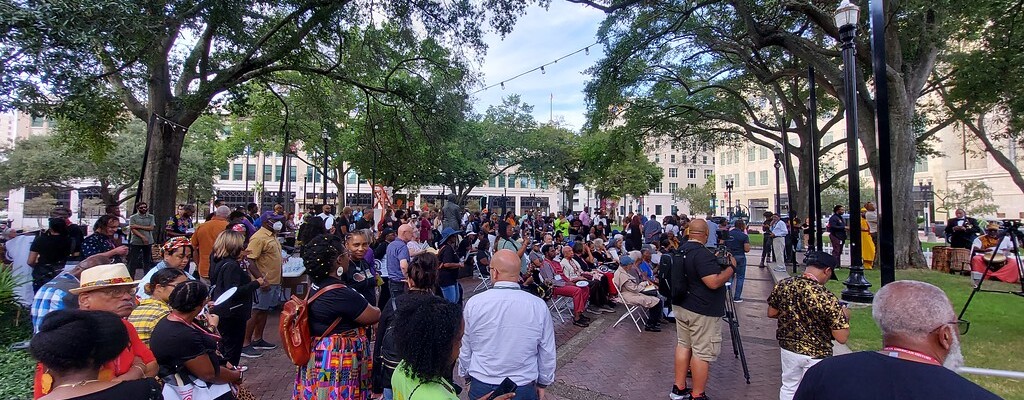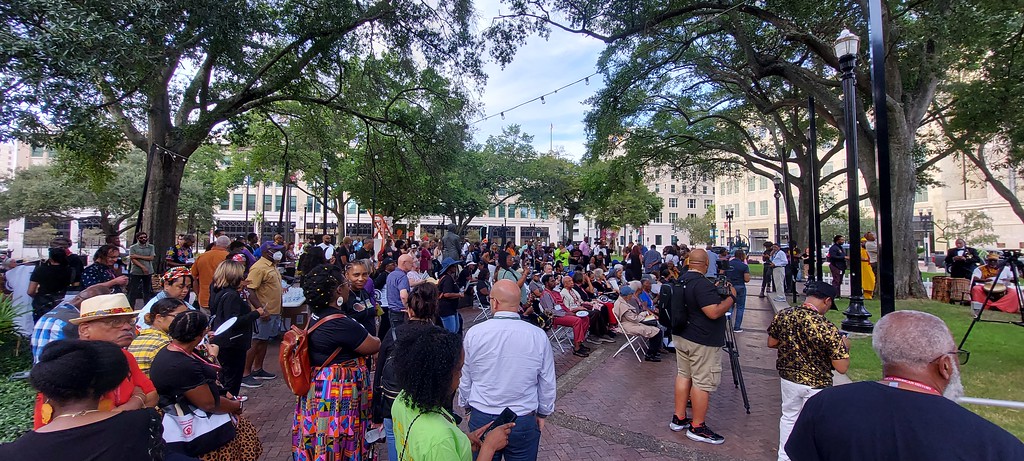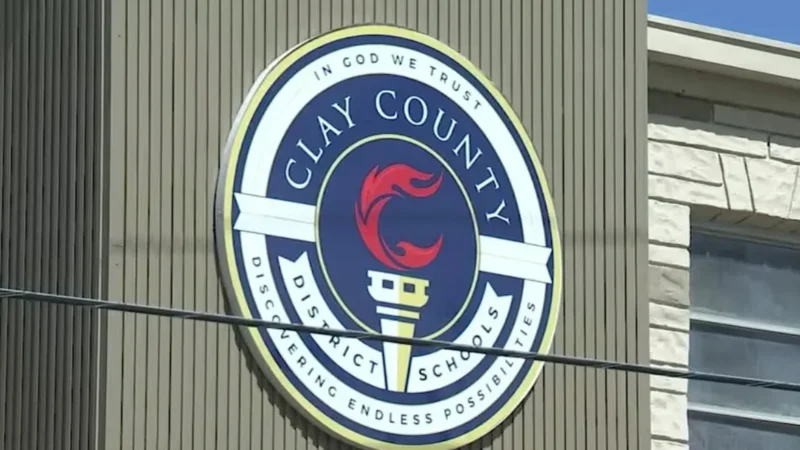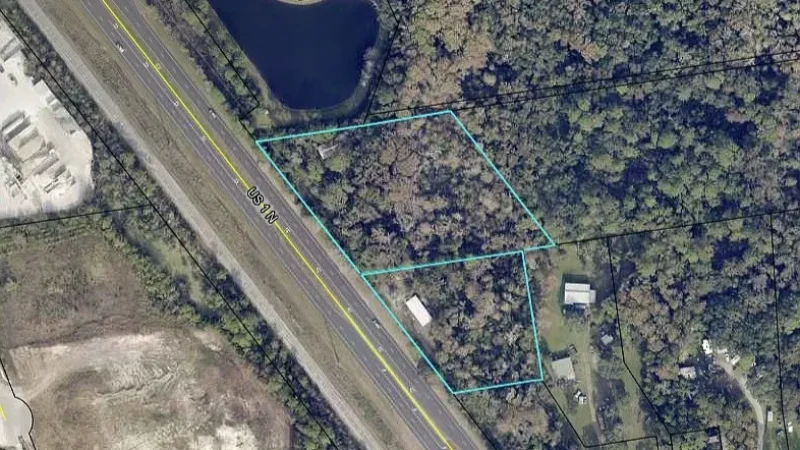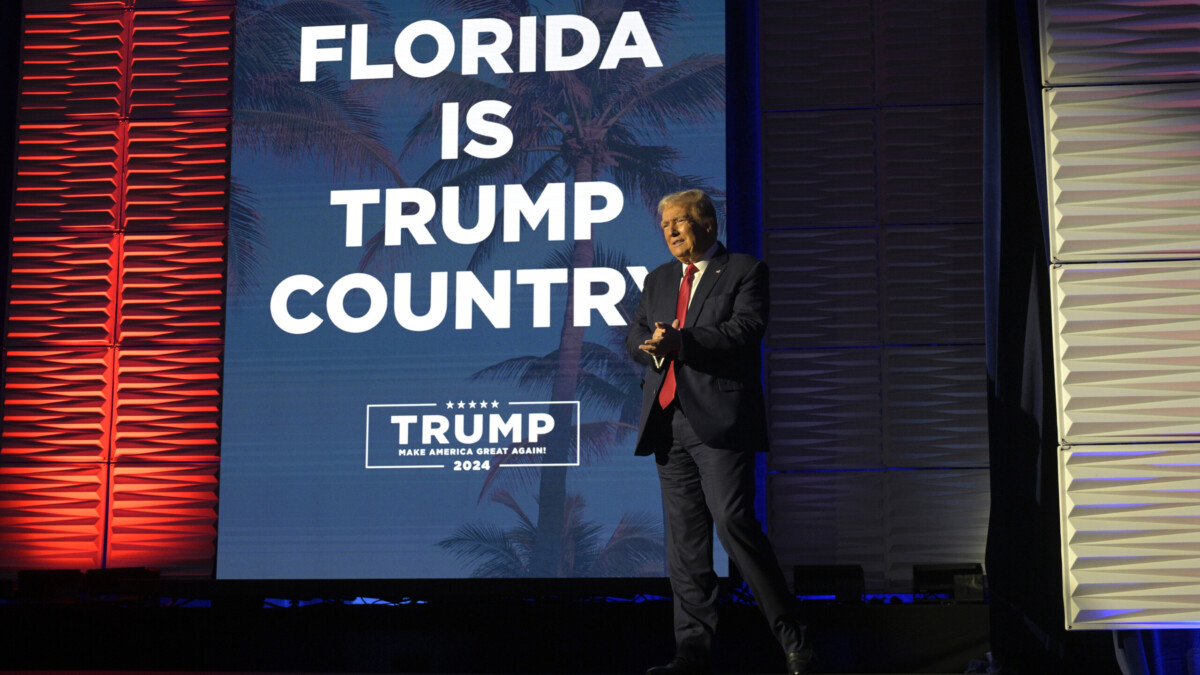
Over the past several years, ambitious plans for new parks along Downtown Jacksonville’s riverfront have been widely discussed. Designs for no fewer than six waterfront parks have been paraded before City Council, reviewed within various civic commissions and shared with the press.
At the same time, conversations about the city’s most historic, resilient, strategically important urban park – the 158-year-old James Weldon Johnson Park, in front of City Hall – have been conspicuously absent from public discourse.
Major sitework has already taken place to remove the park’s 50-year-old fountains. And, per the conservatory that oversees the park, final plans for a redesign are expected by “early 2024,” despite no concepts or designs having been formally shared with the public (just two small, in-person, weekday workshops).
As a city, we’ve been down this road before. Mistakes made during the last redesign of JWJ Park have handicapped Downtown Jacksonville for 50 years, effectively turning our city’s historic town square into a blighted pass-through. With hundreds of millions of dollars in public incentives earmarked for projects on all sides of the park, Jacksonville can’t afford to make that same multi-generational mistake again.
If our goal as a city is to breathe new life into Jacksonville’s urban core, JWJ Park is ground zero to those efforts. Thus, any new plans for James Weldon Johnson Park must be widely shared with the public for feedback, must take the entire surrounding context into consideration, and must be strictly anchored in proven best practices that have revitalized similar urban spaces elsewhere.
A pretty, green park designed in a vacuum won’t move Downtown Jacksonville forward. Only a vibrant, energetic, flexible, economically self-sustaining town square has the potential to catalyze the surrounding blocks, amplify our nearby investments, bring adjacent dead properties back to life, and make good on promises that its 1971 redesign failed to deliver.
So, to honor the park’s 158th birthday this month, I’d like to present a case study from an eerily similar park — New York City’s Bryant Park — that provides the ideal blueprint to set up James Weldon Johnson Park to be successful and self-sustaining for decades to come.
Bryant Park vs. James Weldon Johnson Park

On paper, James Weldon Johnson Park shares a lot in common with New York City’s famed Bryant Park. Both are anchored by their city’s flagship library. Both are bounded by a major public transportation station. They are similar in shape, tree cover and orientation. And they’ve been on parallel paths historically: built in the late 1800s, struggled with blight and poor perception. But when they underwent redesigns in the last 50 years, there were starkly diverging results.
And though Bryant Park is larger than James Weldon Johnson Park, the principles applied there are easily transferable to our smaller, more market-appropriate acreage.
To better understand the drastic difference in outcomes resulting from each space’s most recent redesign, let’s take a brief look at the history of each park.
James Weldon Johnson Park’s history

Within our 875-square-mile city, no single block is as strategically and historically important as the 1.5-acre Downtown plot bounded by Laura, Hogan, Monroe, and Duval streets. City founder Isaiah Hart recognized this as early as 1857, setting the plot aside for use as a public square. Once complete in 1866, City Park (later known as St. James Park, then Hemming Park and now, James Weldon Johnson Park) became Jacksonville’s de-facto town square, serving as the seat of commercial, recreational, and civic activity for over 150 years.
Throughout the early 1900s, flexible greenspace and fixed amenities like the park’s long standing bandshell allowed the space to host weekly (often daily) musical performances, civic events, movie nights and political speeches.
By mid-century, Presidents Eisenhower, Johnson, Kennedy, and Nixon were hosting political rallies in the space, and the city’s largest department stores — JCPenney, Woolworth’s, Furchgott’s, Ivey’s, and May Cohens — had set up shop on its borders. The year 1960 brought the park’s darkest day, Ax Handle Saturday, when civil rights protestors who came to a sit-in at some of these department stores’ whites-only lunch counters were attacked by more than 200 Klansmen while police looked the other way.
Hemming Park experienced rapid decline in the 1980s as surrounding department stores began to close or relocate to the suburbs. In response, as part of a failed 1971 Downtown Master Plan, the park’s remaining grass was ripped out and the space was converted into a brick-and-concrete passthrough.
“The village green has been deserted,” the Times-Union reported at the time, “abandoned to the homeless.”
In the decades that followed, what was eventually rebranded as “Hemming Plaza” became a crime-ridden symbol of Downtown Jacksonville’s fall, even after the adjacent St. James Building was converted into our City Hall in 1997 and our new flagship Main Jacksonville Library was built next door in 2005.
A public/private conservatory, Friends of Hemming Park (now Friends of James Weldon Johnson Park), was established and funded by the city in 2014 to reactivate the space, oversee programming, and create a block that was self-sustaining.
In the decade since, Friends of JWJP has been a tremendous asset to the city. Despite their shoestring budget, the group has brought much-needed stability, programming, and community outreach. If you’ve spent any time in the area, you also know that the staff is as friendly and committed as you’ll find anywhere in Jacksonville.
Since early 2023, Friends of JWJP has been working with Oakland-based HOOD Design Studio on a redesign of the park. Sixteen concepts have been developed as the result of a $1 million grant from the state. Though some of the designs may be great, without seeing them in full, we have no way of knowing. Aside from a few largely illegible images that made their way onto social media, only those able to attend weekday in-person workshops have had the opportunity to view the concepts and provide feedback. When asked if designs shared during the meetings would be made available to the public, the city has been non-committal.
Next, let’s look at a space that has successfully overcome similar struggles and become one of the country’s great urban parks: New York City’s Bryant Park.
Bryant Park’s history
Midtown Manhattan’s Bryant Park, bounded by Fifth and Sixth avenues and 40th and 42nd streets, has its own long, storied history. While JWJ Park has seen its fair share of U.S. presidents, NYC’s like-block saw none other than George Washington lead Revolutionary troops across its grounds.
For much of its early history, the square served as a burial ground for those lost to the devastating yellow fever pandemic (at one time, JWJ Park was also considered for cemetery space). By 1884, the bodies had been moved and Bryant Park had been dedicated, named after longtime New York Evening Post Editor William Cullen Bryant.
As the early 20th century progressed, construction for the adjacent New York Public Library and the Interborough Rapid Transit subway tunnel raged on, with Bryant Park looking more like a storage yard than a city park. Once these projects were finally completed, Bryant Park was given a much-needed grand redesign in 1934.
The park’s 1934 redesign was intended to transform the congested square into a quiet urban oasis, giving New Yorkers respite from the hustle and bustle of the city streets surrounding it. Ironically, it was this celebrated redesign that resulted in the park’s blight in coming decades.
By raising Bryant Park four feet above street level and enclosing it with granite walls, narrow entrances, and tall hedges, the park was nearly impenetrable from the streets, making illicit activity alarmingly easy. A Bryant Park advocate told The New York Times, “It’s incredible, but it seems the park was designed for pushers.” Architectural critic Paul Goldberger joked, “The park could not be seen clearly from the street, and people inside could not see back out to the sidewalk. A set of conditions ideal for drug dealers, but of little comfort to anyone else.”
When a public-private conservatory, the Bryant Park Restoration Corp., took control of the space in the 1980s, they partnered with famed urban planner William Whyte on a safe, vibrant redesign. The park was instantly transformed from a dangerous place that workers avoided to one of NYC’s most popular and beloved urban destinations.
The tentpoles of Whyte’s redesign, which have become a magic formula for successful placemaking in the decades since, include things like built-in flexibility, clear sight lines, a social design, consistent programming, fixed amenities, and diverse revenue streams.
With this in mind, let’s now take a look at five key ideas from Bryant Park’s successful revitalization that we should apply to James Weldon Johnson Park’s redesign to not just build a new park, but to create a vibrant, self-sustaining block that gives Jacksonville’s central business district a much needed shot in the arm.
Key Idea 1: Maximum flexibility

At the heart of Bryant Park lies a 1.4-acre open lawn that acts as a blank canvas for recreation, programming and events. All park amenities (some permanent, some seasonally rotating) border this key central space. Bryant Park’s year-round vibrancy stems from the flexibility and wide variety of uses this design allows.
Plentiful lightweight movable furniture allows visitors to truly make Bryant Park their own. During the spring, the park is as hospitable to friends gathering to catch up over coffee as it is to sunbathers or families wanting to throw a baseball. On select Saturdays, you might find free lunchtime Picnic Performances. On summer evenings, the flexible design allows Bryant Park to host outdoor movie nights, concerts, or theatrical performances. During the fall, you might find a sponsored event ahead of football season or a makers market with dozens of vendors. During the holiday season, when frigid temperatures make the lawn too cold, Bryant Park’s flexibility allows it to stay active by transforming into a seasonal, sponsored winter village.
For a local example of these principles in action, look no farther than the most successful urban park in our city’s long history, Memorial Park in Riverside. Its flexible nature and central lawn have allowed it to stand the test of time when so many of our other parks have not.
In contrast, James Weldon Johnson Park in its current “plaza” design is handicapped by a rigid layout that is more conducive to passing through than to hosting a wide range of events.
Key Idea 2: Maintain clear sight lines

In addition to maintaining flexibility, the open nature of Bryant Park enhances safety, both real and perceived. No matter where you are in Bryant Park, you are within sight of a security officer, and a security officer is within sight of you. Contrast the view of a security guard from the perimeter of Bryant Park below (left) to the view of a security guard from the existing perimeter of James Weldon Johnson Park (right).
Additionally, the clear sightlines allow those on the lawn to enjoy the surrounding world-class architecture free of visual obstruction. In the view below, visitors in the park can easily take in views of the Empire State Building and American Standard Building (now the Bryant Park Hotel).
James Weldon Johnson Park, similarly, is surrounded by some of Jacksonville’s most iconic, historically significant architecture. From the St. James Building to the Main Library, Western Union Telegraph Building (now MOCA), and Hotel Roosevelt (Carling) to the South; the Independent Life Building, Seminole Club, JTA Skyway, and Federal Courthouse and the Snyder Memorial and Bank of America tower all nearby. With such incredible surrounding context, there’s simply no reason to overdesign or over-decorate JWJ Park.
Key Idea 3 – Physical boundaries and placemaking

For decades, James Weldon Johnson Park has lacked identity. Without clear boundaries or a primary entrance, this key block has become nothing more than a passthrough courtyard spilling onto the sidewalks and streets surrounding it. Nothing about the existing design encourages you to stay.
To better establish JWJ Park as a destination, the park should be given a proper entrance on Laura Street. As an example, the wrought-iron arch at New Orleans’ City Park visually orients visitors, while subtly reinforcing the historic nature of the 180-year-old park.
To reinforce a sense of place, branded JWJP shade umbrellas for tables and ample in-park signage should be included in the redesign, like we see at Bryant Park. And, in terms of enhanced security, an unintimidating wrought-iron fence surrounds Bryant Park, creating a clearly defined perimeter while still allowing full visibility into and out of the park. Secondary entrances are present along all sides.
JWJ Park, conversely, lacks physical boundaries, making it prohibitively difficult for security and staff to enforce the park’s rules and to keep bad actors out.
Wrought-iron fences on their own aren’t glamorous, but by building physical boundaries around the park, we are better able to:
- Establish JWJP’s identity as a unique destination, not a pass-through
- Remove rulebreakers from the park, and keep them out
- Secure the park after closing, reducing the need to store movable furniture and discouraging after-hours crime, littering, and vandalism
- Leverage the park for private events on a limited basis, with proceeds going toward upkeep and programming at JWJP
Key Idea 4: Activate the retail bays fronting the park

Retail bays along Laura Street, fronting James Weldon Park.
When discussing the challenges of creating a vibrant James Weldon Johnson Park, we often hear that the park is handicapped because it is surrounded by limited retail space and too much 9-to-5 municipal and private use.
What we rarely hear, however, is that four underutilized retail bays exist directly fronting JWJ Park.
The Main Library contains two retail bays fronting Laura Street. Though these slots once housed a coffee shop and bookstore, they now contribute nothing to Downtown vibrancy at street level. Similarly, MOCA contains two retail slots, one of which is currently occupied by Setlan Coffee.
Activating these four storefronts with outdoor patios to the wide Laura Street sidewalks would add immediate vibrancy at JWJP’s entrance without sacrificing any of the limited acreage within.
Key Idea 5: Avoid turning the park into a passive museum

There’s been a lot of discourse around dedicating a portion of the park as space to solemnly reflect on Ax Handle Saturday. In this guest author’s opinion, the cowardly racists who incited violence that day don’t deserve to be recognized in depth within the park for the violence they inflicted. It only gives more power to their actions.
We should instead use the park to celebrate the multi-year battle that Jacksonville’s NAACP Youth Council fought, and ultimately won, to desegregate nearby Downtown lunch counters. After all, the true story of the park isn’t that the protestors were victimized. It was that they overcame, even when everything (including the local press and police) was rigged against them.
In the spirit of creating an active, rather than passive, James Weldon Johnson Park, we should look to Wichita, Kansas’s interactive lunch-counter protest installation, which leaves open seats for visitors to “sit in” themselves, imagining what it must have felt like to be in the shoes of these brave protestors.
Active, informative installations like this (perhaps fronting former department stores where sit-ins took place), along with a proper celebration of James Weldon Johnson, gives power and positive recognition back to a community that, for too long, couldn’t walk through James Weldon Johnson Park without passing under a statue that declared Confederate enslavers to be Jacksonville’s “heroes.”
At the same time, focusing too much in-park space to tell the story of Jacksonville’s history greatly undermines the park’s true purpose as an active event and recreation space. Bryant Park accomplishes this balance by placing its eight sculptures and monuments on the outer periphery of the park, which allows for maximum flexibility at its center.
With ample space on all four sides of the park, including wide sidewalks and streets that may be able to be recaptured for the park, there’s plenty of room to honor the park, city, and James Weldon Johnson’s history without turning the park proper into a solemn museum.
What do we know about the proposed redesign?

If you, like me, believe that the key to returning James Weldon Johnson Park to its rightful place as Jacksonville’s true civic and cultural epicenter will best come from a flexible design; clear sightlines; a safe, policeable layout; and a holistic approach to not just the park but the entire block, we might have a problem brewing.
Of the 16 designs proposed for the park (taken from a blurry Twitter photograph), almost all the designs appear to be densely filled, hard to secure, and lacking large-scale flexibility. There may be more to them than we can see from a single snapshot, but again, without concepts being shared with the public, it’s hard to know.
The three designs assumed to be finalists – screenshotted below from social media – all appear (from what can be read) to position the park once again as a passive, inflexible space rather than our city’s active town square.
The “Commemorative Circuit” relegates the lawn to a small, awkward, hard-to-program fraction of the overall design, focusing instead on what appears to be a circular history lesson.
The “Commemorative Grove” is even more egregious, cutting the park in half with a massive reflecting pool and shrubbery fronting City Hall. Though the pool may be lovely, it will greatly limit the utility of the park for events and recreation.
The third finalist, titled “¼ Acre Spaces,” carves James Weldon Johnson Park into nine separate micro-spaces, each just a quarter of an acre large. Sensitively speaking, though this design might give the transient community 50 extra places to panhandle out of sight from security, it doesn’t leave enough space for large-scale events or community gathering.
Why is this so important?

As a city, we are at risk of backing ourselves into another 50-year corner if we don’t learn from our past and our peers and again overdesign James Weldon Johnson Park into a tight, passive labyrinth that’s as hard to police as it is to program.
With surplus vacant retail space begging to be reactivated on the park’s periphery, sprawling sidewalks and roads available for historic commemoration, and opportunities for revenue generation on all sides of the park, there’s just no need to try to cram everything into the 1.5 acre boundaries of the park proper.
Instead, by maintaining maximum flexibility for numerous seasonal uses, we can restore James Weldon Johnson Park to its original 1866 purpose as Jacksonville’s premier civic gathering spot. Though Riverfront Plaza may ultimately play host to our largest city events a few weekends a year, the more resilient, more historic JWJ Park will always be our everyday workhorse long after the riverfront is underwater.
A smart redesign will drive engagement and activity in our urban core 365 days a year, feed visitors into surrounding restaurants and shops, make residential living more attractive, increase property values, spark new development, and maximize the public investments that we’re making on all sides of the park.
With real estate this important, literally on our city’s front steps, no one organization should be making multi-generational decisions in the dark, even if they’re all awesome people. The way forward must instead be anchored in widespread communication and best practices already established by world-class parks with similar characteristics.
The decisions we make here are either going to propel Downtown toward reaching its full potential or handcuff the urban core for another 50 years.
If you feel the same way and believe that we need to have a wider conversation about the future of Jacksonville’s most important city block before proceeding with a redesign, please let Friends of James Weldon Johnson Park, the mayor’s office, and your local City Council members know.

